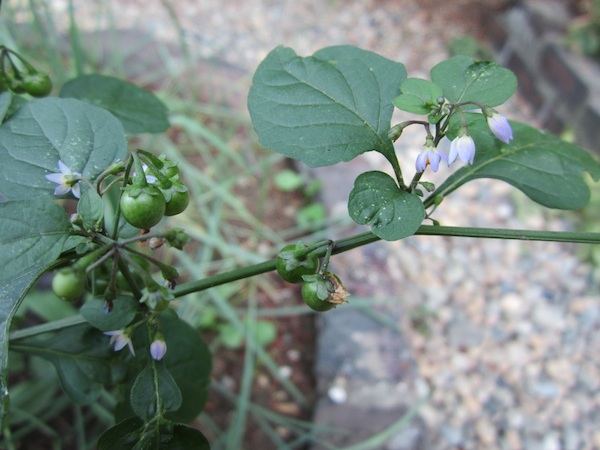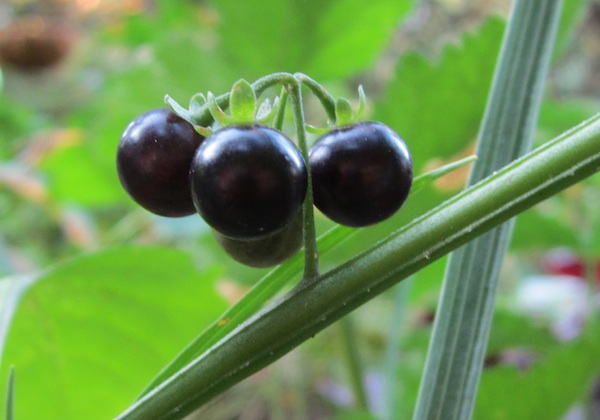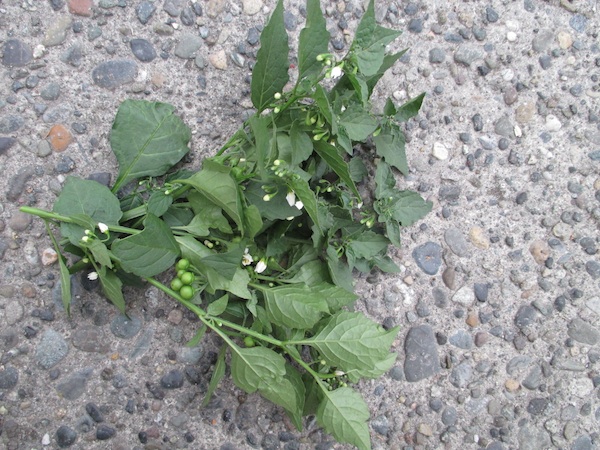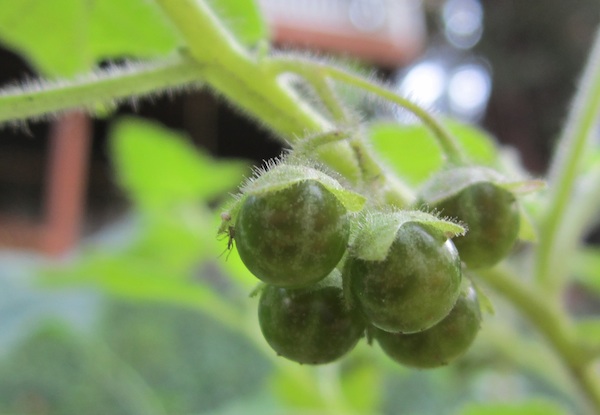| Black Nightshade; Solanum nigrum L. |
| and |
| Hairy Nightshade; Solanum physalifolium Rusby |
Nightshade Family; SOLANACEÆ
|
| Six plants that grow wild in Greater Seattle are called Nightshade. Most common, Bittersweet Nightshade
(Solanum dulcamara), was our first weed-of-the-month (November 1985). It gets miscalled Deadly Nightshade, while true Deadly Nightshade
(Atropa Bella-donna) is exceedingly rare hereabouts (praise be!). As for Prickly Nightshade (Solanum rostratum) and Enchanter's Nightshade (Circæa alpina) I'll say nothing at present, to focus instead on two species fairly common in vegetable gardens: Black Nightshade
and Hairy Nightshade. |
The name "nightshade" is fascinating, and I hope in time to learn to which species the English first applied it, and exactly
why. Philology aside, the name evokes dread from most people, who have heard scary things about Deadly Nightshade, such as
the following words of Gerard, originally penned almost 400 years ago:
|
Nightshade causeth sleep, troubleth the mind, bringeth madnesse if a few of the berries
be inwardly taken, but if moe be given they also kill and bring present death. If you will
follow my counsell, deale not with the same in any case, and banish it from your gardens, and the
use of it also, being a plant so furious and deadly.
|
| But fear not our local nightshades; they outnumber the deadly species a million to one. Some nightshades are even edible.
Can you imagine: "Here, do taste my nightshade pie?" There are five meanings assigned to nightshade in the Language of Flowers:
1) falsehood; 2) dark thoughts; 3) sorcery; 4) witchcraft; 5) scepticism. The truth is: some nightshades are good, others bad. You can fearfully avoid all, or learn who's who. |
| After 25 years of repeated failures, Luther Burbank in 1905 hybridized two nightshades
(S. villosum and S. guineense) to
create an edible-berried plant he named Sunberry. Against Burbank's will, it became known as Wonderberry, and was confused with
the inferior "Garden Huckleberry" whose fruit tastes vile raw. The authentic Sunberry is indeed a superb berry plant. Note that
tomato, potato, eggplant, tomatillo, and red pepper are all cousins in the same nightshade family. |
| In any case, the two weeds of this month are summer annuals of disturbed soil, almost exclusively found in vegetable and
flower beds. Solanum nigrum is the Black nightshade from Europe, and has bigger black berries;
S. physalifoliumis the Hairy (or Green) nightshade from South America, with smaller berries greenish or brown when ripe, and fuzzy stems. Both species bear floppy
dull foliage, and plain tiny white, yellow-centered flowers. They mimic potato fairly well. |
| They are not serious weeds and are easily yanked up. Although a child ingesting their unripe berries may be poisoned, their
fully ripe berries can be cooked into jams or pies if anyone is so inclined. Even the cooked greens have been eaten by some
none-too-fastidious diners. The toxic alkaloid solanine (also in green potatoes, by the way) is destroyed by cooking. In China, Black
nightshade has been used to increase virility. In Europe and North America, herbalists have carefully employed nightshades to serve
worthy healing ends. |
In brief, these two garden nightshade weeds are not to be condemned for the transgressions of their deadly peer. Go ahead,
weed them out, but spare yourself and everyone else any exhibition of horror.
|
Originally published as the Seattle Tilth newsletter Weed of the Month in September 1992, along with an illustration from a book.
Back |

Solanum nigrum flowers, unripe berries; photo by ALJ
|

Solanum nigrum ripe berries; photo by ALJ
|

Solanum nigrum greens ready to cook; photo by ALJ
|

Solanum physalifolium ripe berries; photo by ALJ
|

Solanum physalifolium (left) and Solanum nigrum (right) ripe berries; photo by ALJ
|

